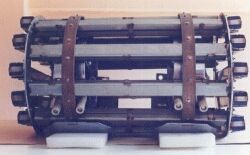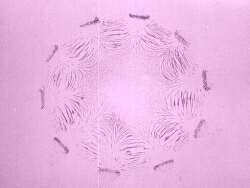The Dusty plasma laboratory was the first high vacuum laboratory to be set up at CPP in the first quarter of 1998. The objectives of this laboratory is to provide the researchers with an opportunity to understand the method of production and maintenance of high vacuum, the method of pro-duction of plasma by the hot cathode discharge method, study the production and formation of dust grains by the Joule heating method as well as to carry out research in the field of dusty plasma.
 | 
The dusty plasma chamber |
The experimental setup basically consists of two vacuum chambers, interconnected by a stainless steel metallic capillary tube, which helps in maintaining a differential pressure between them. A gate valve placed above the capillary regulates the connection between the lower evaporation chamber and the upper chambers.
One of the major experiement carried out at the dusty plasma lab is the measurement of charge on a dust particles embedded in plasma.
Collisionless filament discharge plasma is produced by biasing negatively white hot tungsten filaments with respect to the grounded chamber wall in a rarefied ultra pure argon environment. A multi cusp permanent magnet confinement system is used to enhance the density of the plasma so those particles are fully charged during a finite time of transit through the plasma.

Multi cusp permanent magnet confinement system |  |
In the lower chamber metal is Joule heated in an argon gas environment. In a pressure of the order of 10 mbar, the evaporated atoms form sub mi-cron sized spherical particles. Due to the differen-tial pressure these particles pass through the nozzle and enter the plasma region in the upper chamber in the form of a collimated beam of dust particles.
 | 
Magnetic field profile |
The individual dust grains in the beam get charged as the beam moves through the mag-netically confined plasma. The charged beam then moves through a pair of electrostatic deflec-tor plates placed at the topmost chamber and ul-timately deposit on a glass plate kept at a dis-tance from the top of the deflector plates. The beam suffers deflection inside the plates, when an external voltage is applied across them. From this deviation as recorded by the dust beam sig-nature on the detector glass plate for different applied voltages, the average charge of the dust grains is determined.
Some related experiments (currently underway, and/or will be undertaken shortly):
- The dust number density is an important parameter in any dust-plasma system. A change in the dust number density can cause changes in the plasma parameters as well as in the number of charges collected by dust grains. Also it is essential to know its value to determine whether system is a dust in plasma or dusty plasma.
- Velocity of the dust grains is an important parameter in the formula from which charge acquired by the grains is found out. Hence, its in-situ determination is necessary in order to find out the charge collected by the grains.
- Accurate measurement of charge gained by dust grains in plasmas, by using Langmuir probe (LP) and Retarding Potential Analyzer (RPA) under different parameter regime would be one of the main objectives in the future.
- Study of collisional and non-collisional shock structures would be one more important aim of the investigation, after modifying the device suitably.
- Scattering of low energy ion beam in presence of charged dust cloud and estimation of effective cross section of dust grains would also be carried out.
- Since there is a definite charging time scale of dust grains in plasmas, so there must be a definite discharging time scale also. If both of them are not same, then the measurement of discharging time scale of grains would be one of the main objective of future work.
- This work will be extended to dust crystal formation and related studies on the nature and properties of the dust crystal.
